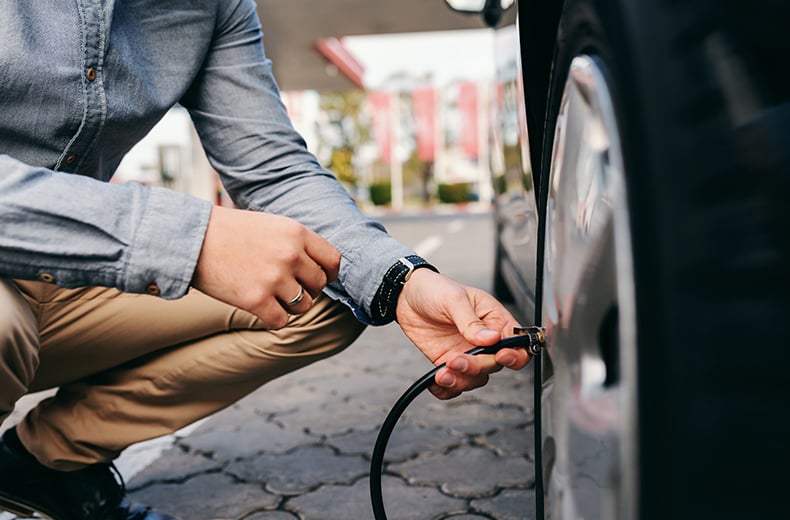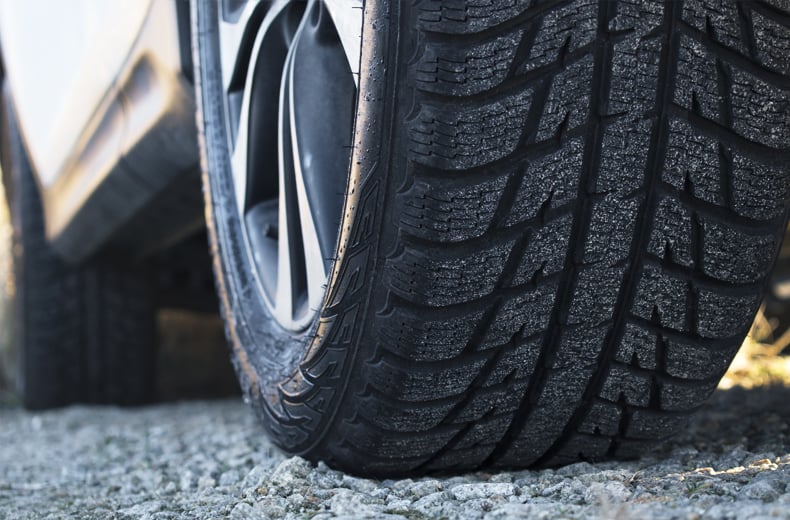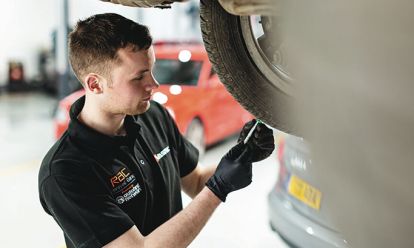Yet, for some motorists, checking their tyre pressure isn’t something they think about between one MOT and the next. That's why it's important to get into the habit of checking your tyre pressure once a month.
Poorly maintained tyres will not only put you at risk on the road, they will also impact your vehicle's running costs with underinflated tyres requiring more force (and fuel) to turn. That's why it's vital that you take care of your car and know how to check the tyre pressure regularly.
To make this easier, we’ve put together a quick guide on how to check your tyre pressure.
Are you worried about your tyres? Check with your local mobile mechanic.
How to check tyre pressure
It is important to inspect your car's tyre pressure regularly. Make sure you check your tyres when they are cold by allowing three to four hours to pass after driving your vehicle to ensure you get the most accurate reading.
To check your tyre pressure, you must:
- Ensure the vehicle is parked safely, with the engine switched off and the handbrake engaged
- Make a note of your car's correct tyre pressure - this will be detailed in the owner's manual and also be on a sticker inside the driver's door frame (identified in PSI and BAR)
- Ensure you have a high quality tyre pressure gauge to hand - digital gauges are popular with car owners
- Remove the valve dust cap from the tyre valve and place the pressure gauge onto the tyre valve stem
- Press down the gauge evenly on the valve stem to ensure you get an accurate reading
- Check the reading on the pressure gauge to determine if you’ll need to deflate or inflate your tyres
- If your tyres need inflating, use a suitable pump and avoid over-inflation by adding small amounts of air at a time
- If your tyres need deflating, use the tip of a flat-head screwdriver to push on the metal pin on the valve stem to release air
- Take regular measurements with the pressure gauge between inflating and deflating
- Check the pressure of your car's spare tyre (if it has one)
Why it's important to check tyre pressure

Tyre pressure affects a vehicle’s performance in a lot of key handling and safety areas, such as how quickly you can brake, your accuracy in handling corners, and the general comfort of your drive.
Fuel consumption is also affected by tyre pressure. A deformed tyre can increase your car’s resistance with the road, meaning your fuel will be working harder and costing you more.
The entire weight of your vehicle is supported by your tyres’ air pressure. As tyres naturally lose a little bit of air every month, it’s essential to check your tyre pressure on a regular basis.

SALE – up to 40% off*
Roadside & Recovery from £5.29 a month*
• Cheaper than AA Price Promise or we’ll beat by 20%^
• We get to most breakdowns in 60 mins or less
• Our patrols fix 4/5 breakdowns on the spot

How to measure tyre pressure
There are two systems used to measure tyre pressure: bar (metric) and pounds per square inch or PSI (imperial).
These are usually quoted together in user handbooks or tyre pressure stickers.
1 Bar = 14.5 PSI if you need to convert.
At petrol stations you’ll almost always be able to select the correct pressure based on either of these measurements. A good home pressuriser will display both numbers on their gauge too.
What should my tyre pressure be?

Most cars come with a sticker somewhere on their bodywork that tells you the correct tyre pressure. This can usually be found on the inside of the driver's door, on the part of the vehicle body that is hidden from view when the door is closed.
Information on the correct pressure will be provided in relation to various loadings (two occupants, four occupants, etc), so it’s important you pick the one that suits your needs.
If your car doesn’t have a sticker, then refer to the owner's handbook or speak with your local garage.
When should I check my tyre pressure?
Tyre pressure should be checked once a month to be sure you’re not driving on inadequately-inflated tyres.
You should always check your tyre pressure when the tyres are cold — i.e. before you’ve made any journeys that day. This is because warm or hot tyres that have recently been driven on may give inaccurate pressure readings.
Can I check my tyre pressure at a petrol station?

Air pumps at fuel stations are often more complex than the ones you might have at home, and many come with +/- buttons that enable you to set the pressure as needed.
On most forecourts you’ll be able to find both a pressure gauge (that gives readings in bar and PSI) and an air pump.
There will often be a third button which provides a ‘rapid fill’ if your tyre is particularly low on air.
How to find the right tyre pressure
You should be able to find the recommended pressure for your tyres on a small sticker on the bodywork of your car, usually inside the driver's doorframe or on the fuel cap. It should also be detailed in the vehicle handbook.
There will be different tyre pressures for a fully loaded and unloaded vehicle, so take a note of this if carrying a full set of passengers and luggage.
There may also be different pressure settings for comfort and fuel economy, with the latter requiring more air to reduce rolling resistance at expense of a harsher ride quality.
Slow punctures

Slow punctures release air from your tyre at a much slower rate than traditional punctures, and can go unnoticed for longer periods of time.
If enough air is released your tyre will eventually lose pressure and become unsafe.
How to identify a slow puncture
There are a few tell-tale signs that you may have a slow puncture:
- Debris stuck in the tyre – the most obvious sign, look out for screws or any other debris piercing your tyres
- Pulled steering – if you loosen your grip on the steering wheel on a flat road you might notice your car pulls to the side
- Vibrating steering wheel – your steering wheel can become unbalanced causing the controls to vibrate, particularly when travelling at a high speed
- Poor handling – your vehicle doesn’t feel as responsive when turning or your suspension feels harder than usual
- Worn tyre sidewall – the sidewalls on low-pressure tyres often come into contact with the road, leading to damage over time
- Misshapen tyre – a tyre that appears out of shape when compared with others usually indicates a change in pressure
- Clicking sounds – if you notice a clicking sound that increases with your speed, you might be hearing debris stuck in the tyre making contact with the road
How do slow punctures happen?
Slow punctures are usually caused by a sharp object piercing the tyre, or the impact of driving over a pothole or raised kerb. A faulty valve can also lead to air leaks.
Regular checks will help you notice any punctures before they become too serious. LINK
Driving with a slow puncture
While it’s possible to drive with a slow puncture, doing so increases the chances of the puncture growing in size and releasing more air.
The increasing loss of pressure will eventually affect your car’s handling and safety before your tyre becomes completely flat.
Slow puncture repair
Although puncture repair kits are widely available, they should only be used as a temporary fix.
They usually come with a glue that’s fed through the valve and then drawn to the puncture, acting as a sealant.
If you suspect you have a slow puncture it’s best to get the help of a professional.
Should I replace my tyre for a slow puncture?
Some slow punctures can be repaired, avoiding the need to replace the tyre completely.
In many cases, garages are able to repair minor damage or simply replace a faulty valve to save on the costs of a new tyre.
How often should I change my tyres?
A number of factors will determine how long a tyre lasts. Tyre design and quality, driver habits, road condition and climate all make a difference.
Michelin suggests you should check your tyres thoroughly at least once a year after five years of use. It also advises replacing 10-year-old tyres, even if they appear in a good state.
You can find the manufacturing date of your tyre using its DOT code, found on the sidewall. Look out for the letters DOT and a set of numbers, the last four digits indicate the manufacture date to the nearest week.
For example, a tyre reading ‘DOT XXXXXXX3116’ will have been made in the 31st week of 2016.
As a general rule, front tyres will last around 20,000 miles, while those at the rear could last 40,000.
Should I get an air compressor?
Air compressors are a great option if you prefer to inflate your tyres away from a petrol station forecourt.
They often come in a compact size with readings given in both PSI and bar measurements. If you think you might need to inflate your car away from home, you can always find models that are powered through your car’s cigarette lighter socket.
Take a look at the RAC’s Compact Air Compressor.
Low tyre pressure
Allowing tyre pressure to run low increases the contact area between your tyres and the road. This leads to:
- Increased resistance – more fuel is needed to turn your wheels as your engine has to work harder
- Uneven wear – the added friction from the large contact area leads to premature wear to the edge of the tyres
- Reduced brake efficiency – braking time will increase when pressure is low
- More punctures – tyres filled with less air are more prone to punctures
Can I drive on a tyre with low pressure?
It may be possible to drive on a tyre with low pressure, but you could find your driving seriously affected.
Expect less responsive handling, heavier turning and a tougher time controlling your vehicle in general. The problems will only escalate with further driving and could have an impact on your safety.
Taking your tyre to a professional as soon as possible could be the difference in paying £20 for a repair job or £200 for a replacement.
High tyre pressure
What happens if tyre pressure is too high?
For many drivers it’s tempting to inflate tyres beyond the recommended measurements to delay a future top-up.
However, an excessively-inflated tyre has a smaller area of contact with the road and can be very unsafe. You can expect:
- Loss of control – reduced contact with the road can seriously affect handling, especially when speeding around corners or on wet, slippery surfaces
- Reduced brake efficiency – the smaller contact area means tyres have to work harder to grip the road when braking, over-inflated tyres tend to skid more too
- Uneven wear – the middle of over-inflated tyres bulge and carry a heavier share of the car’s weight, leading to premature and uneven wear
Does higher tyre pressure give better mileage?
Although low-pressure tyres have a negative effect on your mileage, it’s wrong to assume that over-inflating your tyres will improve fuel efficiency.
High pressure tyres become stiff and require more fuel to navigate bumps and irregularities in the road.
It’s best to avoid sharp and sudden braking, change gears smoothly and make regular maintenance checks to get the most of the petrol in your tank.
Where can I check my tyre pressure and get air for free?
A number of garages, including some of the big chains, offer a free tyre-checking service for your car including pressure readings. You’ll have to ask if they can inflate your tyres too.
Alternatively, a number of petrol stations will offer the services at little or no cost.
Are you experiencing a car fault, warning, or mechanical problem on your road trip? Find a local mechanic with the RAC.
If you're looking for complete peace of mind, then it's worth getting RAC breakdown cover, van breakdown cover or business breakdown cover today.
Get a service or repair at home
RAC Mobile Mechanics can come to you, saving you the hassle of going to a garage.
















